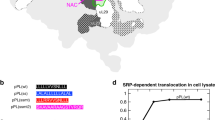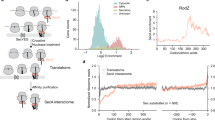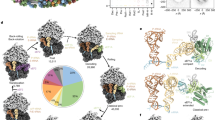Abstract
Signal recognition particle (SRP) is a universally conserved protein–RNA complex that mediates co-translational protein translocation and membrane insertion by targeting translating ribosomes to membrane translocons1. The existence of parallel co- and post-translational transport pathways2, however, raises the question of the cellular substrate pool of SRP and the molecular basis of substrate selection. Here we determine the binding sites of bacterial SRP within the nascent proteome of Escherichia coli at amino acid resolution, by sequencing messenger RNA footprints of ribosome–nascent-chain complexes associated with SRP. SRP, on the basis of its strong preference for hydrophobic transmembrane domains (TMDs), constitutes a compartment-specific targeting factor for nascent inner membrane proteins (IMPs) that efficiently excludes signal-sequence-containing precursors of periplasmic and outer membrane proteins. SRP associates with hydrophobic TMDs enriched in consecutive stretches of hydrophobic and bulky aromatic amino acids immediately on their emergence from the ribosomal exit tunnel. By contrast with current models, N-terminal TMDs are frequently skipped and TMDs internal to the polypeptide sequence are selectively recognized. Furthermore, SRP binds several TMDs in many multi-spanning membrane proteins, suggesting cycles of SRP-mediated membrane targeting. SRP-mediated targeting is not accompanied by a transient slowdown of translation and is not influenced by the ribosome-associated chaperone trigger factor (TF), which has a distinct substrate pool and acts at different stages during translation. Overall, our proteome-wide data set of SRP-binding sites reveals the underlying principles of pathway decisions for nascent chains in bacteria, with SRP acting as the dominant triaging factor, sufficient to separate IMPs from substrates of the SecA–SecB post-translational translocation and TF-assisted cytosolic protein folding pathways.
This is a preview of subscription content, access via your institution
Access options
Subscribe to this journal
Receive 51 print issues and online access
$199.00 per year
only $3.90 per issue
Buy this article
- Purchase on Springer Link
- Instant access to full article PDF
Prices may be subject to local taxes which are calculated during checkout




Similar content being viewed by others
References
Akopian, D., Shen, K., Zhang, X. & Shan, S. O. Signal recognition particle: an essential protein-targeting machine. Annu. Rev. Biochem. 82, 693–721 (2013)
Driessen, A. J. & Nouwen, N. Protein translocation across the bacterial cytoplasmic membrane. Annu. Rev. Biochem. 77, 643–667 (2008)
Oh, E. et al. Selective ribosome profiling reveals the cotranslational chaperone action of trigger factor in vivo. Cell 147, 1295–1308 (2011)
Ast, T., Cohen, G. & Schuldiner, M. A network of cytosolic factors targets SRP-independent proteins to the endoplasmic reticulum. Cell 152, 1134–1145 (2013)
Fontaine, F., Fuchs, R. T. & Storz, G. Membrane localization of small proteins in Escherichia coli. J. Biol. Chem. 286, 32464–32474 (2011)
Schlenstedt, G., Gudmundsson, G. H., Boman, H. G. & Zimmermann, R. Structural requirements for transport of preprocecropinA and related presecretory proteins into mammalian microsomes. J. Biol. Chem. 267, 24328–24332 (1992)
Johnson, N. et al. TRC40 can deliver short secretory proteins to the Sec61 translocon. J. Cell Sci. 125, 3612–3620 (2012)
del Alamo, M. et al. Defining the specificity of cotranslationally acting chaperones by systematic analysis of mRNAs associated with ribosome-nascent chain complexes. PLoS Biol. 9, e1001100 (2011)
Castanié-Cornet, M. P., Bruel, N. & Genevaux, P. Chaperone networking facilitates protein targeting to the bacterial cytoplasmic membrane. Biochim. Biophys. Acta 1843, 1442–1456 (2014)
Bukau, B., Reilly, P., McCarty, J. & Walker, G. C. Immunogold localization of the DnaK heat shock protein in Escherichia coli cells. J. Gen. Microbiol. 139, 95–99 (1993)
Clarke, D. J., Jacq, A. & Holland, I. B. A novel DnaJ-like protein in Escherichia coli inserts into the cytoplasmic membrane with a type III topology. Mol. Microbiol. 20, 1273–1286 (1996)
Zhang, X., Rashid, R., Wang, K. & Shan, S. O. Sequential checkpoints govern substrate selection during cotranslational protein targeting. Science 328, 757–760 (2010)
Nakatogawa, H., Murakami, A., Mori, H. & Ito, K. SecM facilitates translocase function of SecA by localizing its biosynthesis. Genes Dev. 19, 436–444 (2005)
Lim, B. et al. Heat shock transcription factor σ32 co-opts the signal recognition particle to regulate protein homeostasis in E. coli. PLoS Biol. 11, e1001735 (2013)
Bornemann, T., Jöckel, J., Rodnina, M. V. & Wintermeyer, W. Signal sequence-independent membrane targeting of ribosomes containing short nascent peptides within the exit tunnel. Nature Struct. Mol. Biol. 15, 494–499 (2008)
Krogh, A., Larsson, B., von Heijne, G. & Sonnhammer, E. L. Predicting transmembrane protein topology with a hidden Markov model: application to complete genomes. J. Mol. Biol. 305, 567–580 (2001)
Fluman, N., Navon, S., Bibi, E. & Pilpel, Y. mRNA-programmed translation pauses in the targeting of E. coli membrane proteins. eLife 3, e03440 (2014)
Kuroiwa, T., Sakaguchi, M., Omura, T. & Mihara, K. Reinitiation of protein translocation across the endoplasmic reticulum membrane for the topogenesis of multispanning membrane proteins. J. Biol. Chem. 271, 6423–6428 (1996)
Bischoff, L., Wickles, S., Berninghausen, O., van der Sluis, E. O. & Beckmann, R. Visualization of a polytopic membrane protein during SecY-mediated membrane insertion. Nature Commun. 5, 4103 (2014)
Hessa, T. et al. Molecular code for transmembrane-helix recognition by the Sec61 translocon. Nature 450, 1026–1030 (2007)
Lee, H. C. & Bernstein, H. D. The targeting pathway of Escherichia coli presecretory and integral membrane proteins is specified by the hydrophobicity of the targeting signal. Proc. Natl Acad. Sci. USA 98, 3471–3476 (2001)
Crooks, G. E., Hon, G., Chandonia, J. M. & Brenner, S. E. WebLogo: a sequence logo generator. Genome Res. 14, 1188–1190 (2004)
Hoffmann, A., Bukau, B. & Kramer, G. Structure and function of the molecular chaperone Trigger Factor. Biochim. Biophys. Acta 1803, 650–661 (2010)
Ariosa, A., Lee, J. H., Wang, S., Saraogi, I. & Shan, S. O. Regulation by a chaperone improves substrate selectivity during cotranslational protein targeting. Proc. Natl Acad. Sci. USA 112, E3169–E3178 (2015)
Bornemann, T., Holtkamp, W. & Wintermeyer, W. Interplay between trigger factor and other protein biogenesis factors on the ribosome. Nature Commun. 5, 4180 (2014)
Pugsley, A. P. The complete general secretory pathway in Gram-negative bacteria. Microbiol. Rev. 57, 50–108 (1993)
Kadokura, H. & Beckwith, J. Detecting folding intermediates of a protein as it passes through the bacterial translocation channel. Cell 138, 1164–1173 (2009)
Sääf, A., Andersson, H., Gafvelin, G. & von Heijne, G. SecA-dependence of the translocation of a large periplasmic loop in the Escherichia coli MalF inner membrane protein is a function of sequence context. Mol. Membr. Biol. 12, 209–215 (1995)
Gamerdinger, M., Hanebuth, M. A., Frickey, T. & Deuerling, E. The principle of antagonism ensures protein targeting specificity at the endoplasmic reticulum. Science 348, 201–207 (2015)
Kramer, G., Guilbride, D. L. & Bukau, B. Finding nascent proteins the right home. Science 348, 182–183 (2015)
Casadaban, M. J. Transposition and fusion of the lac genes to selected promoters in Escherichia coli using bacteriophage lambda and Mu. J. Mol. Biol. 104, 541–555 (1976)
Kramer, G. et al. Functional dissection of Escherichia coli trigger factor: unraveling the function of individual domains. J. Bacteriol. 186, 3777–3784 (2004)
Becker, A. H., Oh, E., Weissman, J. S., Kramer, G. & Bukau, B. Selective ribosome profiling as a tool for studying the interaction of chaperones and targeting factors with nascent polypeptide chains and ribosomes. Nature Protocols 8, 2212–2239 (2013)
Hessa, T. et al. Recognition of transmembrane helices by the endoplasmic reticulum translocon. Nature 433, 377–381 (2005)
Rutkowska, A. et al. Large-scale purification of ribosome-nascent chain complexes for biochemical and structural studies. FEBS Lett. 583, 2407–2413 (2009)
Acknowledgements
We thank members of the Bukau laboratory for valuable contributions; C. Gläßer for support with data analysis; and H. Bernstein for providing plasmid pHQ4. Sequencing was done at the Genomics & Proteomics Core (DKFZ) facility. I.P. and R.C.W. acknowledge support from the Klaus Tschira Foundation. This work was supported by research grants from the Deutsche Forschungsgemeinschaft (SFB638 and FOR1805) to G.K. and B.B., a Human Frontier Science Program grant to B.B. and a grant from the Swedish Research Council to G.v.H.
Author information
Authors and Affiliations
Contributions
B.B. and G.K. conceived the study. D.S., B.B. and G.K. designed the experiments. D.S. and F.G. performed the experiments. D.S., I.P., R.C.W., P.B., G.vH., B.B. and G.K. analysed the data. B.B. and G.K. wrote the manuscript. All authors discussed the results and commented on the manuscript.
Corresponding authors
Ethics declarations
Competing interests
The authors declare no competing financial interests.
Additional information
Data have been deposited in the Figshare database and are accessible from https://dx.doi.org/10.6084/m9.figshare.2058051.
Reviewer Information
Nature thanks N. Stern-Ginossar and the other anonymous reviewer(s) for their contribution to the peer review of this work.
Extended data figures and tables
Extended Data Figure 1 Selective ribosome profiling of E. coli SRP.
a, Experimental scheme of selective ribosome profiling (SeRP) of E. coli SRP-bound RNCs. Cells were harvested in mid-log phase via rapid filtration, frozen in liquid nitrogen and lysed in a frozen state with a cryo mill. After thawing, polysomes were digested with micrococcal nuclease. Monosomes were purified by sucrose cushion centrifugation (translatome). SRP-bound RNCs were immunopurified using an SRP-specific polyclonal rabbit antibody (SRP interactome). b, Bioanalyzer spectra quantifying the amount of co-purified ribosomes in control immunoprecipitation (top) and SRP immunoprecipitation (bottom). The 16S ribosomal RNA (rRNA) of the small ribosomal subunit and the 23S rRNA of the large subunit are indicated. c, Reproducibility of translatome (left) and SRP interactome (right) data sets from biological replicates d, Gene expression levels of translatome and SRP interactome are compared. Only SRP substrates that pass a threshold of twofold enrichment are coloured according to localization (cytoplasm in blue, inner membrane in red, outer membrane, lipoproteins and periplasm in green, no localization known in grey). e, CopA ratio-enrichment profile of SRP interactome and translatome, Pearson correlation coefficient 0.74. Light grey shadows indicate the variation between two biological replicates. f, DsbA ratio-enrichment profile, Pearson correlation coefficient 0.67. Shadows as in e. g, DnaK ratio-enrichment profile of SRP interactome and translatome. Shadows as in e.
Extended Data Figure 2 Selective ribosome profiling of E. coli SRP omitting detergents.
a, Gene expression levels of the translatome and SRP interactome are compared for different experimental setups (with detergents in lysis and wash buffer (n = 2), detergent only in wash buffer (n = 2) and omitting detergents at all (n = 1)). ORFs are coloured according to localization (cytoplasm in blue, inner membrane in red, outer membrane, lipoproteins and periplasm in green, no localization known in grey). b, DsbA ratio-enrichment profile in the absence of detergents (n = 1). c, Metagene SRP interaction profile aligned to the N terminus of the initial TMD that is skipped in the presence of detergents (orange) and in the absence of detergents (black). d, Ratio-enrichment profiles in the absence of detergents of MetI, MsbA and ManZ (n = 1).
Extended Data Figure 3 Interaction profiles of SRP with nascent YnhF, YohO, YbgT, MgrB and YbhT.
Light grey shading indicates the variation between two biological replicates.
Extended Data Figure 4 Heatmap representation of TMD positioning of inner membrane SRP substrates at the time point of first SRP binding.
TMDs are shown in dark red and segments (loops) located outside the membrane bilayer are shown in light grey, dashed lines indicate the area of the ribosomal tunnel exit. Substrates that are bound by SRP without exposing a TMD near the ribosome surface are shown at amino acid resolution. Amino acid colour code: highly hydrophobic amino acids, black; medium hydrophobic amino acids, dark grey; low hydrophobic amino acids, light grey; basic amino acids, blue; acidic amino acids, red; helix breakers, green.
Extended Data Figure 5 NuoA ratio enrichment profile of SRP binding.
Binding events are correlated with topology. SRP binds nascent NuoA when the first TMD is still buried in the tunnel. Light grey shadows indicate the variation between two biological replicates.
Extended Data Figure 6 SRP interaction profiles.
a–c, SRP interaction profile with nascent UraA (a), MetI (b) and SecY (c). SRP-binding peaks are correlated with protein topology. Light grey shading indicates variation between two biological replicates. d, SRP interaction profile with nascent CyoA in wild-type (WT) cells and cells overexpressing SRP and FtsY. Shading as in a–c.
Extended Data Figure 7 SRP interaction with purified RNCs at different salt concentration.
Left, cartoons illustrating the composition of nascent chains. Right, SRP–RNC interaction at indicated salt (ammonium acetate) concentrations analysed by sucrose cushion centrifugation and SDS–PAGE. Proteins are visualized using SYPRO Ruby Protein Gel Stain (Thermo Fisher Scientific). I, purified SRP; P, ribosomal pellet fraction; S, supernatant.
Extended Data Figure 8 Quantification of ribosome-exposed nascent-chain binding properties of SRP.
Four categories of binding markers (aliphatic amino acids, FILV motif, helix breakers and aromatic amino acids) quantified in bound TMDs, skipped TMDs and signal sequences.
Extended Data Figure 9 Interaction profile of TF and SRP with nascent MrcA.
TF, blue; SRP, orange. Light grey shading indicates the variation between two biological replicates.
Supplementary information
Supplementary Table 1
This file contains additional details about the proteome-wide SeRP data of SRP-nascent chain interactions in E. coli. Read counts of the translatome and the SRP interactome are compared, substrate identification methods are highlighted, quality scores (pearson correlation coefficient) are listed, initial SRP binding sites are given, retargeting and skipping events are indicated and topology information is provided. (XLSX 2035 kb)
Supplementary Table 2
This file contains an analysis of the properties of bound and skipped transmembrane domains (TMDs), and signal sequences. (XLSX 10 kb)
Rights and permissions
About this article
Cite this article
Schibich, D., Gloge, F., Pöhner, I. et al. Global profiling of SRP interaction with nascent polypeptides. Nature 536, 219–223 (2016). https://doi.org/10.1038/nature19070
Received:
Accepted:
Published:
Issue Date:
DOI: https://doi.org/10.1038/nature19070
This article is cited by
-
Interactions between nascent proteins and the ribosome surface inhibit co-translational folding
Nature Chemistry (2021)
-
The effects of codon bias and optimality on mRNA and protein regulation
Cellular and Molecular Life Sciences (2021)
-
Protein Transport Across the Bacterial Plasma Membrane by the Sec Pathway
The Protein Journal (2019)
-
Hydrophobicity, rather than secondary structure, is essential for the SRP dependent targeting of GPR35 to the ER membrane
Journal of Bioenergetics and Biomembranes (2019)
-
Cotranslational protein targeting to the membrane: Nascent-chain transfer in a quaternary complex formed at the translocon
Scientific Reports (2018)
Comments
By submitting a comment you agree to abide by our Terms and Community Guidelines. If you find something abusive or that does not comply with our terms or guidelines please flag it as inappropriate.



